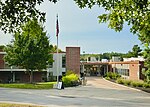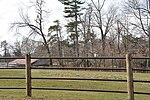Nourse-Farwell House
Buildings and structures in Harvard, MassachusettsFederal architecture in MassachusettsHouses completed in 1800Houses in Worcester County, MassachusettsMassachusetts building and structure stubs

The Nourse-Farwell House is located in the Harvard Center Historic District, a U.S. Historic District in the center of Harvard, Massachusetts. The house is believed to have been built in c. 1800 by Harvard resident Benjamin Nourse. The house was sold in 1833 to John Farwell who served as a Harvard town selectman in 1854 and assessor from 1860 to 1863.The house still stands today located on Elm Street located off of the Harvard Town Common.
Excerpt from the Wikipedia article Nourse-Farwell House (License: CC BY-SA 3.0, Authors, Images).Nourse-Farwell House
Elm Street,
Geographical coordinates (GPS) Address Nearby Places Show on map
Geographical coordinates (GPS)
| Latitude | Longitude |
|---|---|
| N 42.501 ° | E -71.585 ° |
Address
Elm Street 1
01451
Massachusetts, United States
Open on Google Maps










